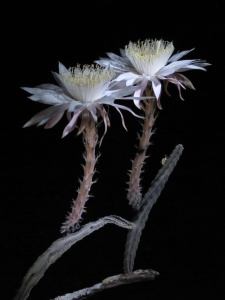The Night Blooming Cerus, or Queen of the Night, (Peniocereus greggii) is a Sonoran Desert cactus that most of the year would be virtually impossible to find. It’s main stem is a thin, dull-green to brown stalk that resembles the branch of shrubs like the palo verde, Ironwood, or creosote bushes that it normally grows beneath.
What makes this cactus special is that on certain summer nights the plants in each population produce large blooms synchronously – with some plants producing numerous flowers, some producing one and some none at all. The flowers open at sunset and last for one night, withering in the morning sun.
 The flowers are produced only at night, are mostly white, about 3 inches wide and are strongly scented (though some people apparently cannot smell them). The flowers have long floral tubes and are pollinated by hawk moths (Sphingidae) which fly hundreds of yards between different plants in search of nectar. In return they exchange pollen between individuals.
The flowers are produced only at night, are mostly white, about 3 inches wide and are strongly scented (though some people apparently cannot smell them). The flowers have long floral tubes and are pollinated by hawk moths (Sphingidae) which fly hundreds of yards between different plants in search of nectar. In return they exchange pollen between individuals.
The Night Blooming Cerus is actually not a cerus at all. When cacti were first collected and categorized they were lumped into one genus named ‘Cactus’. Later, taxonomists determined that there were several groups of cacti and split the plants into groups like Opuntia (beaver tail cacti), mammillaria (fish-hook cacti), Cerus (columnar cacti) and others. In the newer classification many columnar cacti were lumped into the Cerus genus, the Night Blooming Cerus being one of them – hence it’s name. However later work further subdivided plants in the Cerus genus into more groups. Columnar cacti like the Giant Saguaro remained in the genus Cerus, but vine-like cacti like the Night Blooming Cerus were moved into a new genus named ‘Peniocerus’, where the species is currently classified.
In Arizona and New Mexico, the Night Blooming Cerus is a protected or endangered species that has seen much of its habitat lost to agricultural and urban development. In addition, its future is dependent upon hawk moths which themselves are vulnerable to impacts from nearby development. For example, where pesticides are heavily used in agricultural areas adjacent to desert habitat, the hawk moth populations can be greatly reduced, such that few remain to pollinate the Night Blooming Cerus to help maintain the cactus’ population size.
Photos from the 2012 Night Bloom at Tohono Chul Park:
All images on this page copyright 2012 by John Donoghue II. All rights reserved.
For more information, see:
- USDA Plants Profile: http://plants.usda.gov/java/profile?symbol=pegr3
- Arizona Sonora Desert Museum: http://www.desertmuseumdigitallibrary.org/public/detail.php?id=ASDM02376&sp=Peniocereus%20greggii
- Ladybird Johnson Wildflower Center: http://www.wildflower.org/plants/result.php?id_plant=PEGR3
Leave a comment